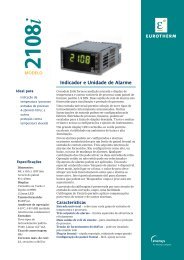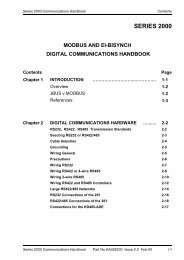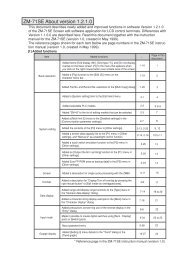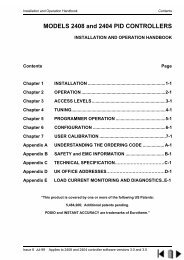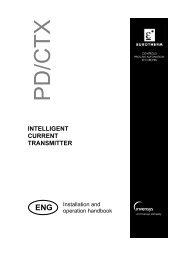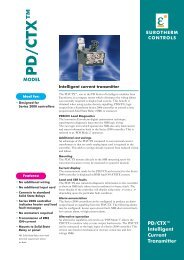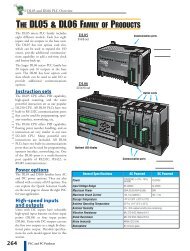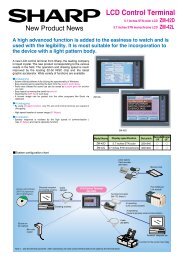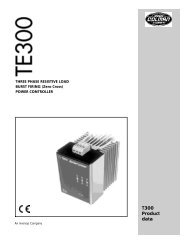model 2704 controller installation and operation handbook - Soliton
model 2704 controller installation and operation handbook - Soliton
model 2704 controller installation and operation handbook - Soliton
Create successful ePaper yourself
Turn your PDF publications into a flip-book with our unique Google optimized e-Paper software.
<strong>2704</strong> Controller Loop Set Up<br />
9.4. CASCADE CONTROL<br />
9.4.1. Overview<br />
Cascade control is a technique used to enable processes with long time constants to be<br />
controlled with the fastest possible response to process disturbances, including setpoint<br />
changes, whilst still minimising the potential for overshoot. It is a combination of two PID<br />
<strong>controller</strong>s, where the output signal from one (the master) forms the setpoint for the other (the<br />
slave). For cascade control to be effective the slave loop should be more responsive than the<br />
master.<br />
9.4.2. Simple Cascade<br />
The main process is controlled using the master PID loop, the output of which is used to<br />
determine the setpoint of the slave. The implementation of cascade control in the <strong>2704</strong> is<br />
available as a st<strong>and</strong>ard option. ie ; it is not necessary to order a dual loop <strong>controller</strong> to<br />
perform cascade control.<br />
9.4.3. Cascade with Feedforward<br />
An available option with cascade control is feedforward. It allows either the master PV,<br />
master SP or user defined variable to be fed forward so that it directly influences the slave<br />
setpoint. The master PID output contribution of the slave setpoint is limited by the trim limit<br />
set in engineering units. This parameter also adjusts the gain of the feedforward path.<br />
A typical application for SP feedforward could be in a heat treatment furnace, where it can be<br />
used to extend the life of heating elements by limiting their maximum operating temperature.<br />
An application using PV feedforward could be in autoclaves or reactor vessels where it is<br />
sometimes required to protect the product from excessive temperature gradients (also referred<br />
to as Delta T Control).<br />
9.4.3.1. St<strong>and</strong>ard Feedforward<br />
St<strong>and</strong>ard feedforward is used if there is a requirement for some additional parameter, for<br />
example an analogue input, to trim the master PID output value before the slave setpoint is<br />
applied. An application may be a liquid temperature control system using cascade control of<br />
heater temperature where variations in control rate can be directly fed forward into the slave<br />
loop, modifying heater temperature <strong>and</strong> giving rapid compensation<br />
9.4.4. Auto/Manual Operation<br />
Auto/Manual operates on both master <strong>and</strong> slave loops.<br />
When the <strong>controller</strong> is placed in manual the slave working setpoint will track the value of the<br />
slave process value continually, therefore ensuring bumpless transfer.<br />
When cascade is deactivated the master loop will monitor the setpoint of the slave loop <strong>and</strong><br />
provide a smooth transition of output power when the loop moves back to cascade mode.<br />
Installation <strong>and</strong> Operation H<strong>and</strong>book. Part No HA026502 Issue 1.0 Apr-00 9-9



